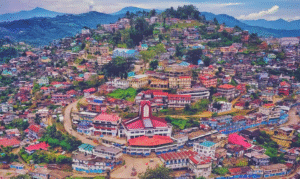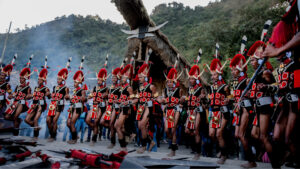Introduction
The vibrant cultural heritage of India is richly displayed through its myriad folk dances, each echoing the life, rhythm, and identity of the communities they belong to. One such unique dance form is Hojagiri, an exceptional folk dance of Tripura, performed by the Bru (Reang) tribe. Deeply intertwined with agrarian rituals and harvest celebrations, Hojagiri is not just a performing art but a living expression of the tribe’s social customs, traditional aesthetics, and spiritual values. This dance captures the essence of gratitude, reverence, and festivity that mark the harvest season.
This academic overview explores Hojagiri in detail—from its historical context and ritual significance to the dance’s choreography, costumes, musical accompaniments, and evolving relevance in modern cultural narratives.
The Cultural and Ethnic Roots of Hojagiri
Hojagiri belongs to the Bru (Reang) tribe, an indigenous community residing primarily in the hilly terrains of Tripura. Known for their semi-nomadic lifestyle, the Brus have long depended on jhum cultivation (shifting agriculture), growing crops such as rice, maize, and vegetables. Their agrarian way of life is deeply connected with natural cycles and seasons.
The origin of Hojagiri is rooted in the community’s ritual practices and folklore. It is traditionally performed during Laxmi Puja, a post-harvest festival, symbolizing prosperity and gratitude for the yield. The dance is also performed to please Goddess Mailuma, considered the protector of crops and households.
Hojagiri is not merely entertainment—it is a ritual act of thanksgiving, performed with reverence and precision. Its uniqueness lies in the acrobatic dexterity displayed by the performers, all while maintaining grace and rhythm.
Ritual Significance and Symbolism
The timing of the dance, usually after the harvest, reflects the tribe’s respect for agrarian cycles. The festival during which Hojagiri is performed is a collective expression of relief and joy after the labor-intensive farming season. Symbolically, it is a gesture to invoke the blessings of deities for continued prosperity and protection from misfortune.
Unlike many Indian folk dances performed by both genders, Hojagiri is exclusively performed by young women, generally in groups of four to six. The male members of the tribe typically play the instruments and oversee the ritual aspects.
In essence, Hojagiri becomes a fusion of worship, performance, and cultural education, reaffirming the tribe’s ancestral knowledge and beliefs.
Dance Movements and Choreographic Elements
What sets Hojagiri apart is the extraordinary balance and body control exhibited by the performers. The dance focuses primarily on the movement of the lower half of the body, while the upper body remains almost immobile—a rare technique in Indian folk traditions.
Some defining elements of the choreography include:
- Balancing on earthen pitchers while performing intricate steps.
- Holding oil lamps or bottles on the head while moving gracefully.
- Balancing objects like brass plates or bottles on hands or knees.
- Circular formations and synchronized group sequences.
- Smooth hip movements that emulate the sway of wind or water.
The dancers maintain an unwavering composure as they complete the choreography with smiles and concentration, showcasing not only physical agility but also inner discipline.
These movements are not just artistic—they carry symbolic meanings. For instance, balancing acts represent the fragility of livelihood and the need for harmony with nature. The dancer’s stability reflects the community’s hope for a stable harvest and peaceful coexistence.
Costume and Visual Aesthetics
Hojagiri is visually mesmerizing, not just because of its movements but also due to the traditional attire and adornments worn by the dancers. The costume plays an essential role in elevating the aesthetic appeal and is reflective of the Bru identity.
The costume typically includes:
- A Rignai (traditional woven wrap-around skirt), often adorned with tribal motifs and bright colors.
- A blouse or wrap for the upper body, simple and functional to allow freedom of movement.
- Heavy use of tribal jewelry, including bead necklaces, bangles, and ear ornaments.
- Hair neatly tied in a bun or left flowing, often decorated with flowers.
- The application of natural pigments and face decorations like vermilion or turmeric paste during festivals.
The bright costumes, in contrast with the earthy setting of rural Tripura, create a vivid spectacle that blends movement, color, and ritual significance.
Musical Instruments and Songs
The rhythm of Hojagiri is driven by tribal instruments played live during the performance. The music is minimal but rhythmic, designed to complement the dancer’s movements.
Key instruments used include:
- Khamb: A traditional drum made of wood and animal skin.
- Sarinda: A string instrument similar to a fiddle, often used in folk narratives.
- Flutes and cymbals: To provide melodic and percussive balance.
The songs sung during the performance are usually folk hymns, sung in the Reang dialect. These lyrics often recount stories of deities, farming life, love, and seasonal changes. The music is hypnotic, often repetitive, building a trance-like rhythm that synchronizes with the dancer’s steps.
The interplay between music and dance forms an integrated spiritual experience—one that is celebratory yet sacred.
Community Participation and Gender Roles
In the context of community engagement, Hojagiri is a collaborative endeavor. While women are the central performers, men are involved in setting up the ritual space, playing instruments, and managing event logistics. Elders oversee the ritual purity of the performance and ensure that the dance adheres to traditional norms.
This gendered division reflects the broader tribal structure, where roles are often divided yet complementary. The young girls selected to perform are trained over time, highlighting intergenerational transmission of knowledge.
The dance also serves as a rite of passage for young girls entering adulthood, symbolizing their growing responsibilities and grace. Thus, the performance becomes a metaphor for transition, maturity, and cultural continuity.
Contextual Changes and Modern Relevance
In recent decades, Hojagiri has moved from village courtyards to national stages. It is now frequently performed during state festivals, tourism events, and cultural exchange programs. While this expansion has increased visibility and pride in cultural identity, it has also raised concerns regarding authenticity and ritual dilution.
In its traditional setting, Hojagiri is performed after proper ritual offerings, fasting, and prayers. In contrast, commercial performances often strip the dance of its sacred context, focusing only on its acrobatic appeal.
Despite these shifts, efforts are being made to preserve the original form. Tribal councils and cultural departments in Tripura are promoting community-led performances and cultural education programs. Schools and colleges are including folk arts in their curriculum, and NGOs are documenting and archiving oral histories related to Hojagiri.
The dance continues to be a source of identity and resilience for the Bru tribe, especially in the context of displacement and socio-political challenges faced by the community over the years.
Comparative Insights: Hojagiri and Other Indian Harvest Dances
Hojagiri shares the thematic essence of thanksgiving and celebration with other Indian harvest dances, yet it remains uniquely Reang in its style and symbolism.
- In Punjab, Bhangra and Giddha are energetic dances celebrating Vaisakhi, marked by fast-paced beats and group dynamics.
- In Assam, Bihu celebrates the agricultural season with swaying movements and songs of love and labor.
- In Tamil Nadu, the folk dances during Pongal are performed with decorated bulls and clay pots.
However, Hojagiri’s balancing acts and minimalist music distinguish it from these more exuberant forms. It is contemplative, symbolic, and deeply ritualistic—a folk dance that dances on the threshold between sacred performance and everyday spirituality.
Preservation Through Policy and Education
The Government of Tripura and cultural wings of the Indian government have acknowledged the importance of preserving indigenous traditions like Hojagiri. Measures include:
- Funding tribal cultural festivals where original forms of Hojagiri are showcased.
- Documenting the oral and ritual traditions related to the dance.
- Supporting community-based training centers that teach the youth the correct techniques and spiritual significance of the dance.
- Recognizing Hojagiri performers with folk artist awards to enhance social status and pride.
Scholars and cultural anthropologists are also working on research that delves into the semiotics, choreography, and anthropology of Hojagiri, ensuring it remains both studied and celebrated.
Conclusion
Hojagiri stands as a testament to the rich cultural expressions of India’s tribal communities, particularly the Reang tribe of Tripura. More than a folk dance, it is a ritual expression of ecological harmony, social balance, and spiritual gratitude. Every graceful sway, every carefully balanced earthen pitcher, and every rhythm of the drum echoes the community’s enduring connection with land, tradition, and the divine.
In a world rushing toward modernization, Hojagiri serves as a cultural anchor—reminding us of the value of rootedness, community, and sacred celebration of life’s most essential rhythms: sowing, reaping, and rejoicing.






